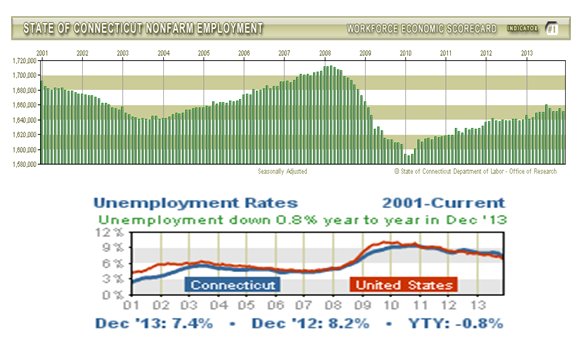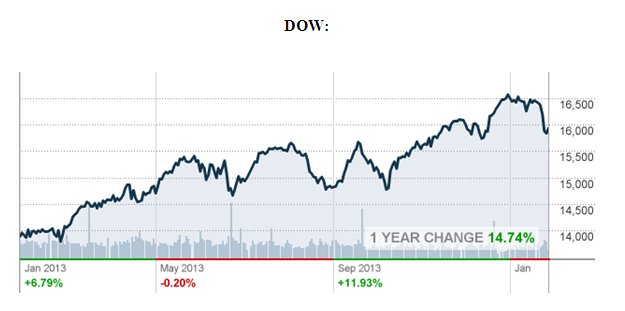Comptroller Kevin Lembo Archive > News
COMPTROLLER LEMBO PROJECTS GROWING SURPLUS OF $506.1 MILLION FOR FISCAL YEAR 2014Comptroller Kevin Lembo today announced that the state's outlook for Fiscal Year 2014 continues to grow positive with a current projected surplus of $506.1 million - an increase of $232.9 million over last month.
In a letter to Gov. Dannel P. Malloy, Lembo said he agrees with the Office of Policy and Management's (OPM) latest projection, which incorporates the latest Jan. 15 consensus revenue estimates. The consensus forecast has increased anticipated income tax receipts by $213.1 million.
Lembo commended Malloy's recently announced plan to direct
significant portions of the current projected surplus towards the Budget Reserve
Fund and to pay down debt.
"As you know, I have advocated for the deposit of General Fund surplus dollars
to the state's Budget Reserve Fund in accordance with current law," Lembo wrote
to Malloy.
The reserve balance at the end of Fiscal Year 2013 was $270.7 million - representing 1.6 percent of net appropriations. Should the legislature enact Malloy's plan, an additional $250 million would be deposited to the Budget Reserve Fund, bringing the balance to $520.7 million or just over 3 percent of planned spending.
"I have advocated for a reserve level of 15 percent of spending, which is also endorsed within your surplus distribution plan," Lembo wrote. "Significant dollars in reserve will guard against future tax increases and service reductions during inevitable future recessionary cycles.
Lembo urged that any additional surplus realized by the end of the fiscal year also be directed to the Budget Reserve Fund.
"As the disposition of the surplus is debated, policy makers should remember that the Fiscal Year 2014 General Fund budget relies on $190.8 million in nonrecurring revenue reserved from the prior year and $112.4 million in carry forward funding," Lembo said. "In addition, the majority of the surplus dollars in Fiscal Year 2014 result from a one-time tax amnesty program, and from the most volatile component of the income tax, which relies on strong stock market performance. Finally, both OFA (Office of Fiscal Analysis) and OPM have estimated budget shortfalls beginning in Fiscal Year 2016 if current policies remain unchanged.
"I recommend that any General Fund surplus realized by the close of Fiscal Year 2014 in excess of this month's estimate be deposited directly to the Budget Reserve Fund."
Lembo reported that the estimated payment portion of the income tax is driving the higher income tax projection. Estimated payments grew by almost 25 percent through January of last fiscal year. This large increase was partially attributable to a capital gains tax change that went into effect at the end of calendar year 2012 and resulted in a roll-forward of taxable gains to Fiscal Year 2013. Absent the tax change, these roll-forward gains would have been realized in future years.
The current budget plan anticipated a softening of estimated payments in Fiscal Year 2014, based on the roll-forward activity. However, estimated payments through January of this fiscal year continued to post year-over-year growth in excess of 4.5 percent. This positive performance in the estimated payment component of the income tax is expected to continue through Fiscal Year 2014.
Total General Fund revenue for 2014 is expected to exceed initial budget targets by $421.2 million. In addition, the stock market has continued to post double-digit gains that continue to lift estimated income tax payments as discussed above.
All major revenue categories are exceeding or are close to original estimates, and spending projections are below initial budget targets, Lembo said.
Data and other information from federal and state Departments
of Labor and other sources show:

- The employment-driven withholding portion of the state income tax is up 1.5 percent on a fiscal year-to-date basis through December. Last fiscal year the withholding portion of the income tax posted a decline.
- According to Department of Labor data, the state lost 3,900 jobs in December. This more than eliminated the 3,800 jobs gained in November. In 2013, the state posted eight months of job gains and four months of job losses. Nationally, job gains occurred in every month of 2013. The national rate of job growth in 2013 was more than double Connecticut's growth rate.
- For the 12-month period ending in December, Connecticut added 11,500 payroll
positions. Job growth in 2013 averaged 958 positions per month; in 2012, job
additions averaged 717 positions per month. Connecticut has now recovered 59,400
positions, or 49.0 percent of the 121,200 seasonally adjusted total nonfarm jobs
that were lost in the state in the March 2008 - February 2010 employment
recession. Listed below is a table provided by the Department of Labor showing
sector gains and losses for 2013.
Connecticut's Ten Industry Supersector Performance (YTD December 2013: 5 up, 5
down, before revisions)
| 1.) Education and Health Services (7,900, 2.5%) | 6.) Information (-600, -1.9%) |
| 2.) Construction and Mining (5,800, 11.4%, combined) | 7.) Government (-1,300, -0.5%) |
| 3.) Trade, Transportation, and Utilities (4,200, 1.4%) | 8.) Financial Activities (-1,300, -1.0%) |
| 4.) Professional and Business Services (1,400, 0.7%) | 9.) Other Services (-1,400, -2.2%) |
| 5.) Leisure and Hospitality (800, 0.6%) | 10.) Manufacturing (-4,000, -2.5%) |
- Connecticut's unemployment rate in December stood at 7.4 percent. This
compares to a national rate of 6.7 percent.

- Personal income in Connecticut grew at a rate of 0.8 percent between the second and third quarters of 2013. This ranked Connecticut 37th nationally in income growth. On a full year basis, growth was 3.5 percent. For calendar year 2012, Connecticut personal income advanced at a 3.4-percent rate. Data for the fourth quarter will be released on March 25.
- Average hourly earnings at $28.00, not seasonally adjusted, were down 31 cents, or -1.1 percent from the December 2012 hourly private sector pay estimate. The resulting average private sector weekly pay was calculated at $940.80, down $27.40, or -2.8 percent over the year.
- The year-to-year change in the Consumer Price Index for All Urban Consumers (CPI-U, U.S. City Average) in December 2013 was 1.5 percent.

- A strong housing market has lifted Connecticut's real estate conveyance tax receipts by almost double the amount posted through December of last fiscal year.
- According to a report from Berkshire Hathaway Home Services, there were 28,058 single family home sales in Connecticut in 2013, 12.3 percent higher than the number of sales in 2012 and totaling $11.4 billion in sales volume, one of the best years since 2006. At the same time, condominium closings totaled 7,174 up 19.8 percent. Growth in home sales was strongest in Fairfield, Litchfield, Hartford, Windham and New London Counties.
- Median price increased 2.8 percent to $255,000 for single family properties and up 3.4 percent to $167,000 for condominiums. New Haven County median prices grew the most with a 4.3 percent change in single families and Litchfield grew 17 percent in condominiums.
- Connecticut's foreclosure activity rate stands at 3.5 percent, the percentage of all mortgaged homes in some sort of legal action, according to data collecting company CoreLogic. This ranks the State in 5th place in the United States tied with the State of Maine for highest percentage of foreclosure inventory as a percent of all mortgaged homes. Lowering foreclosure inventories will help the real estate market improve.
- Nationally, existing home sales in 2013 were at their strongest level since 2006. Sales were up 9.1 percent from a year ago. The national median existing-home price for all of 2013 was $197,100, which is 11.5 percent above the 2012 median of $176,800, and was the strongest gain since 2005 when it rose 12.4 percent.
- First-time buyers accounted for 27 percent of purchases in December, down from 28 percent in November and 30 percent in December 2012.
- Regionally, existing-home sales in the Northeast slipped 1.5 percent to an annual rate of 640,000 in December, but are 3.2 percent higher than December 2012. The median price in the Northeast was $239,300, up 3.6 percent from a year ago.
- The estimated payment portion of the income tax grew by almost 25% through January of last fiscal year. This large increase was partially attributable to a capital gains tax change that went into effect at the end of 2012 and resulted in a roll-forward of taxable gains to Fiscal Year 2013. Absent the tax change, these roll-forward gains would have been realized in future years. The budget plan anticipated a softening of estimated payments in Fiscal Year 2014 based on the roll-forward activity. However, estimated payments through January of this fiscal year are up by more than 4.5%.
- Estimated payments are impacted by market gains and losses. Although the stock market has experienced some volatility recently over the past several weeks, at this writing the Dow continues to post double digit gains for the year.

CONSUMERS
- Through December the sales tax was advancing at a 9.2% rate on a fiscal year to date basis. This follows year-to-date growth of just 1.6% through November.
- In December, advance retail sales were up 4.1 percent from one year ago. For the full calendar year 2013, sales were 4.2 percent higher than in 2012. The strongest gains for 2013 were in the motor vehicle category-- up 8.7 percent, and non-store retailers--up 10.3 percent. Department stores saw a sales decline of 4.7 percent.
- The Conference Board reported that the consumer confidence index, which had decreased sharply in October and declined slightly in November, was up in both December and January. Both business conditions and the job market were rated more favorably.
- According to the Federal Reserve, in November, consumer credit increased at a seasonally adjusted annual rate of 4.8 percent. Revolving credit increased at an annual rate of just 0.6 percent, while non-revolving credit increased at an annual rate of 6.4 percent.
- Based on the January 30 release by the Bureau of Economic Analysis, real GDP increased at a rate 3.2 percent in the 4th quarter of 2013. This follows growth of 4.1 percent in the 3rd quarter. The deceleration in real GDP in the fourth quarter reflected a deceleration in private inventory investment, a larger decrease in federal government spending, a downturn in residential fixed investment, and decelerations in state and local government spending and in nonresidential fixed investment that were partly offset by accelerations in exports and in personal consumption expenditures and a deceleration in imports.
- Corporate profits posted growth of 5.7 percent from one year ago in the 3nd quarter of 2012. Profits grew by better than 7 percent in both 2011 and 2012. Fourth quarter profits will be reported on March 27.
- The Labor Department's scorecard of business activity looks at trends in housing permits, air cargo, Connecticut exports, state gaming revenue, visitors to major state attractions, air passengers, the manufacturing index in Connecticut and weekly hours worked in the state in order to gage business health. The index has posted some positive movement toward the end of 2013.

